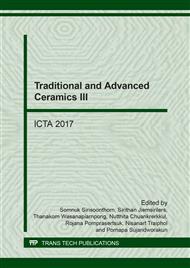p.51
p.58
p.65
p.71
p.77
p.83
p.88
p.94
p.99
Fracture Energy and Fracture Toughness of In Situ Calcium Hexaluminate (CA6)-Alumina Monolithic Refractory
Abstract:
One of main raw materials for monolithic refractory is calcium aluminate cement which provides CA6 hexagonal plate-like microstructure with self-toughening properties and fracture resistance. In the present study, in-situ CA6 was formed by using sintered alumina mixing with alumina cement in stoichiometric composition to achieve 100 mass% and 50 mass% of CA6 in alumina monolithic refractory with 2 mass% of silica addition. Samples were fired from 1400-1500°C for 5 h and characterized for physical and mechanical properties. The results showed that both samples could not obtain CA6 content as expected and apparent porosity did not exhibit in the same tendency. However, only proper amount of CA6 content could gain proper amount of apparent porosity which is the main effect of mechanical properties. Especially the formation of CA6 lower than 50 mass% with the presence of low melting phase caused low apparent porosity and led to high fracture toughness and effective fracture energy.
Info:
Periodical:
Pages:
77-82
Citation:
Online since:
April 2018
Authors:
Price:
Сopyright:
© 2018 Trans Tech Publications Ltd. All Rights Reserved
Share:
Citation:


